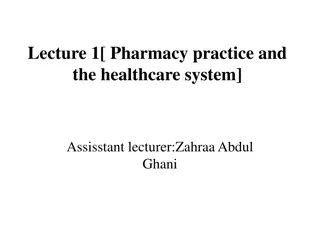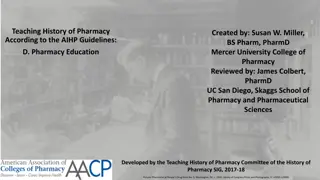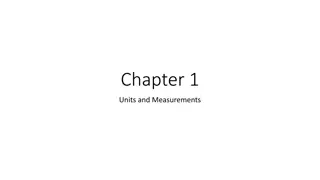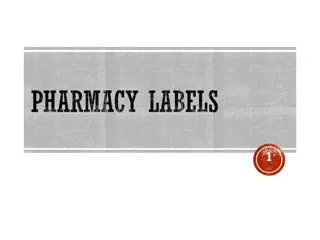Pharmacy Practice Guidelines for SI Units
The transition to the International System of Units (SI) in pharmacy practice is essential for standardized and accurate communication. This system emphasizes clarity, simplicity, and consistency in the use of unit names and symbols. Guidelines include proper capitalization, placement of decimal markers, avoiding combining symbols with spelled-out terms, and ensuring numeric values fall between 1 and 1000 for readability and precision.
Download Presentation

Please find below an Image/Link to download the presentation.
The content on the website is provided AS IS for your information and personal use only. It may not be sold, licensed, or shared on other websites without obtaining consent from the author.If you encounter any issues during the download, it is possible that the publisher has removed the file from their server.
You are allowed to download the files provided on this website for personal or commercial use, subject to the condition that they are used lawfully. All files are the property of their respective owners.
The content on the website is provided AS IS for your information and personal use only. It may not be sold, licensed, or shared on other websites without obtaining consent from the author.
E N D
Presentation Transcript
Principles of pharmacy practice Lec 1 Lecturer Dr Athmar Dhahir Habeeb Al-Shohani PhD in industrial pharmacy and pharmaceutical formulations athmar1978@uomustansiriyah.edu.iq athmar1978@yahoo.com athmar.habeeb.12@ucl.ac.uk
The International System of Units (SI) Formerly called the metric system, is the internationally recognized decimal system of weights and measures. Today, the pharmaceutical research and manufacturing industry, the official compendia, the United States Pharmacopeia National Formulary, and the practice of pharmacy reflect conversion to the SI system. The reasons for the transition include 1. The simplicity of the decimal system, 2. The clarity provided by the base units and prefixes of the SI 3. The ease of scientific communications through the use of a standardized and internationally accepted system of weights and measures and professional
guidelines for the correct use of the SI Unit names and symbols generally are not capitalized except when used at the beginning of a sentence or in headings. However, the symbol for liter (L) may be capitalized or not. Examples: 4 L or 4 l, 4 mm, and 4 g; not 4 Mm and 4 G. In the United States, the decimal marker (or decimal point) is placed on the line with the denomination and denominate number; however, in some countries, a comma or a raised dot is used. Examples: 4.5 mL (U.S.); 4,5 mL or 4 5 mL (non-U.S.). Periods are not used following SI symbols except at the end of a sentence. Examples: 4 mL and 4 g, not 4 mL. and 4 g. A compound unit that is a ratio or quotient of two units is indicated by a solidus (/) or a negative exponent. Examples: 5 mL/h or 5 mL h1, not 5 mL per hour.
Symbols should not be combined with spelled-out terms in the same expression. Examples: 3 mg/mL, not 3 mg/milliliter. Plurals of unit names, when spelled out, have an added s. Symbols for units, however, are the same in singular and plural. Examples: 5 milliliters or 5 mL, not 5 mLs. Two symbols exist for microgram: mcg (often used in pharmacy practice) and g (SI). The symbol for square meter is m2; for cubic centimeter, cm3; and so forth. In pharmacy practice, cm3is considered equivalent to milliliter. The symbol cc, for cubic centimeter, is not an accepted SI symbol. Decimal fractions are used, not common fractions. Examples: 5.25 g, not 51 4 g.
A zero should be placed in front of a leading decimal point to prevent medication errors caused by uncertain decimal points. Example: 0.5 g, not .5 g. To prevent misreadings and medication errors, trailing zeros should not be placed following a whole number on prescriptions and medication orders. Example:5 mg not 5.0mg. However, in some tables (such as those of the SI in this chapter), pharmaceutical formulas, and quantitative results, trailing zeros often are used to indicate exactness to a specific number of decimal places. In selecting symbols of unit dimensions, the choice generally is based on selecting the unit that will result in a numeric value between 1 and 1000. Examples: 500 g, rather than 0.5 kg; 1.96 kg, rather than 1960 g; and 750 mL, rather than 0.75 L.
Measure of Volume The liter is the primary unit of volume The United Formulary2 states: One milliliter (mL) is used here in as the equivalent of 1 cubic centimeter (cc). States Pharmacopeia National
Measure of Weight The primary unit of weight in the SI is the gram
This table may also be written: Equivalencies of the most common weight denominations:
Fundamental Computations 1.Reducing Denominations by Using a Unit-Position Scale The metric system is based on the decimal system; therefore, conversion from one denomination to another can be done simply by moving the decimal point. 1- To change a metric denomination to the next smaller denomination, move the decimal point one place to the right. 2-To change a metric denomination to the next larger denomination, move the decimal point one place to the left. SI Units to Lower or Higher
Examples: Reduce 1.23 kilograms to grams. 1.23 kg = 1230 g, answer.
Reduce 85 micrometers to centimeters. 85 mcm = 0.085 mm = 0.0085 cm, answer. Reduce 2.525 liters to microliters. 2.525 L = 2525 mL = 2,525,000 L, answer
2- Reducing SI Units to Lower or Higher Denominations by Ratio and Proportion or by Dimensional Analysis Examples: Reduce 1.23 kilograms to grams. From the table: 1 kg =1000 g
Reduce 62,500 mcg to g. From the table: 1 g = 1,000,000 mcg























